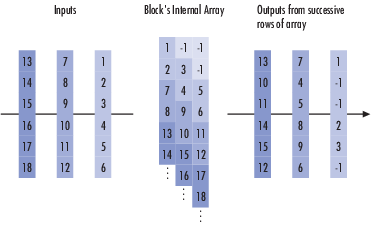Helical Interleaver
Permute input symbols using helical array
Library
Convolutional sublibrary of Interleaving
Description
The Helical Interleaver block permutes the symbols in the input signal by placing them in an array in a helical fashion and then sending rows of the array to the output port.
The block uses the array internally for its computations. If C is the Number of columns in helical array parameter, then the array has C columns and unlimited rows. If N is the Group size parameter, then the block accepts an input of length C·N at each time step and partitions the input into consecutive groups of N symbols. Counting from the beginning of the simulation, the block places the kth group in the array along column k mod C. The placement is helical because of the reduction modulo C and because the first symbol in the kth group is in row 1+(k-1)· s, where s is the Helical array step size parameter. Positions in the array that do not contain input symbols have default contents specified by the Initial condition parameter.
The block sends C·N symbols from the array to the output port by reading the next N rows sequentially. At a given time step, the output symbols might be the Initial condition parameter value, symbols from that time step's input vector, or symbols left in the array from a previous time step.
This block accepts a column vector input signal containing C·N elements.
The block can accept the data types int8, uint8,
int16, uint16, int32,
uint32, boolean, single,
double, and fixed-point. The data type of this output will be the
same as that of the input signal.
Parameters
- Number of columns in helical array
The number of columns, C, in the helical array.
- Group size
The size, N, of each group of input symbols. The input width is C times N.
- Helical array step size
The number of rows of separation between consecutive input groups in their respective columns of the helical array.
- Initial conditions
A scalar that fills the array before the first input is placed.
Examples
Suppose that C = 3, N = 2, the Helical array step
size parameter is 1, and the Initial condition
parameter is -1. After receiving inputs of [1:6]',
[7:12]', and [13:18]', the block's internal
array looks like the schematic below. The coloring of the inputs and the array indicate
how the input symbols are placed within the array. The outputs at the first three time
steps are [1; -1; -1; 2; 3; -1],
[7; 4; 5; 8; 9; 6], and
[13; 10; 11; 14; 15; 12]. (The outputs
are not color-coded in the schematic.)

Pair Block
References
[1] Berlekamp, E. R. and P. Tong. "Improved Interleavers for Algebraic Block Codes." U. S. Patent 4559625, Dec. 17, 1985.
Extended Capabilities
Version History
Introduced before R2006a